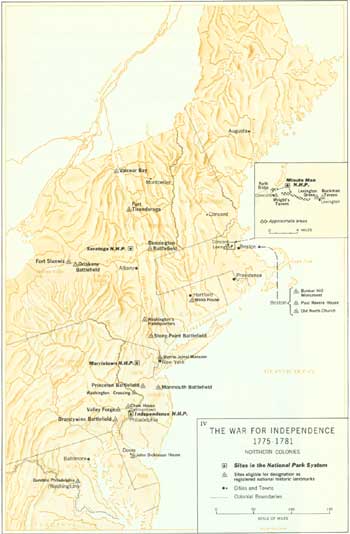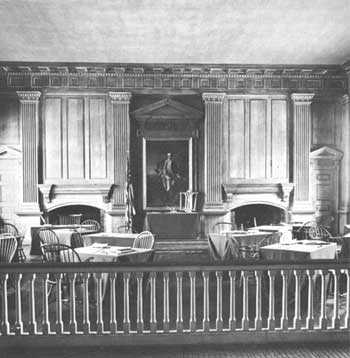





Historical Background
A New Government
When the Second Continental Congress met in Philadelphia on May 10, 1775, war had begun. The delegates recognized this fact by formal declaration and went on to create a Continental Army, naming one of their own number as commander, George Washington. The Congress also issued a "Declaration of the Causes of Taking up Arms" on July 6, 1775, but moved for a final attempt at reconciliation in the "Olive Branch Petition." This document, asking the Crown to protect American rights from Parliamentary tyranny, was spurned by George III.
 |
| Map IV. The War for Independence, 1775-1781. (click on image for an enlargement in a new window) |
As 1775 passed, American sentiment gradually drifted away from the original desire for a guarantee of rights within the British Empire. The King announced plans on October 26 to hire foreign mercenaries to subdue the colonists. In January 1776 Thomas Paine published "Common Sense," which sounded the call for a complete and final break with England. The tide soon ran strongly for independence, which was adopted on July 4, 1776.
With the Declaration of Independence, the Colonies faced the necessity of establishing a formal union to carry on the war. Although a committee to consider the problem was appointed in June 1776, Congress did not approve a draft of the Articles of Confederation and send it to the States for ratification until November 15, 1777. Most States acquiesced within a few months, but the required unanimous approval was lacking until March 1, 1781, when Maryland ratified.
With the beginning of the movement toward independence in late 1775, the Continental Congress appointed a secret committee to establish relations with foreign governments. Arthur Lee, Massachusetts colonial agent in London, was assigned to the task. He soon won the support of Caron de Beaumarchais, popular French playwright and secret agent of France.
Congress sent Silas Deane to France in 1776, and he helped obtain secret aid in the form of arms and supplies. During the summer of 1776 Deane was joined by Lee and Benjamin Franklin. The trio were charged with securing French recognition of the United States and, if possible, military assistance. Partly because of the diplomatic skill of Deane and his colleagues, and partly because of the course of military events in America in 1777, the diplomats attained both objectives in treaties signed on February 6, 1778. Efforts to win overt Spanish support failed, although Spain gave clandestine aid and entered the war against England as an ally of France in 1779.
 |
| A view of the room in Independence Hall where the Declaration of Independence was signed. The original silver inkstand used by the signers is visible on the table beneath the painting of George Washington. (National Park Service) |
 |
 |
http://www.cr.nps.gov/history/online_books/colonials-patriots/introi.htm
Last Updated: 09-Jan-2005